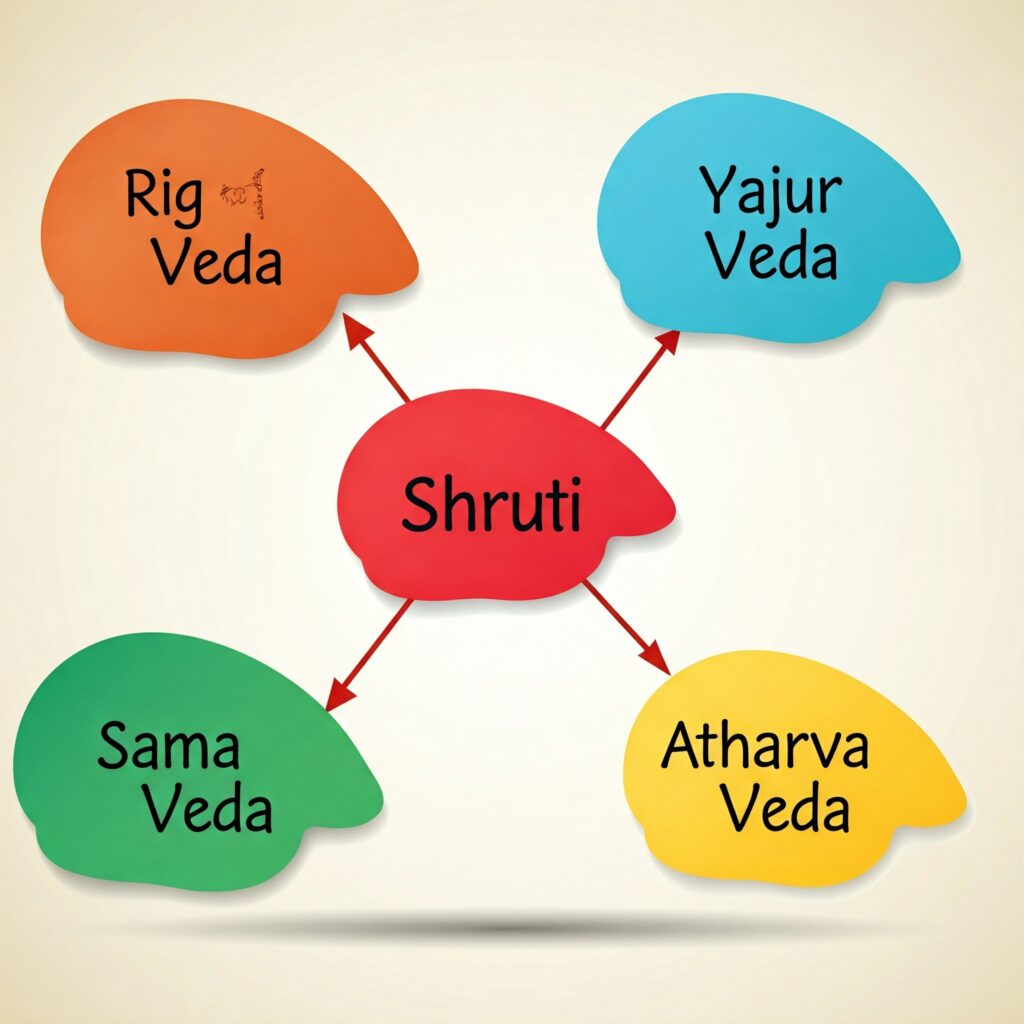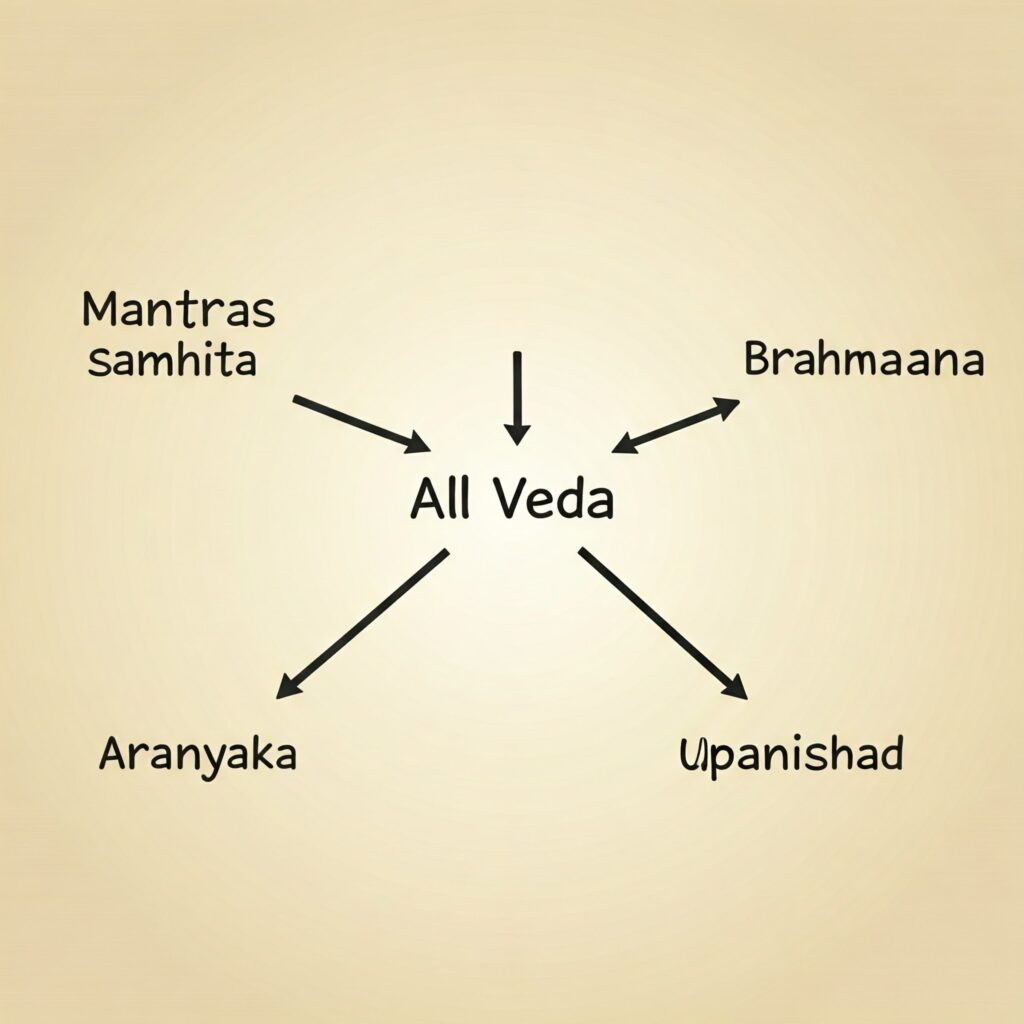Hinduism Scriptures / Hindu Sacred Books
Hinduism Scriptures / Hindu Sacred Books
Hindu religion scriptures are mainly divided into two category Shruti and Smriti
Shruti vs. Smriti:
- Shruti: “What is heard” – divine revelations, includes the Vedas.
- Smriti: “What is remembered” – includes epics and other texts, such as the Ramayana and Mahabharata.
Shruti Scripture :
Shruti and Smriti are two distinct concepts in Hindu philosophy. Shruti, meaning “that which is heard,” refers to the divine revelations received by ancient sages and recorded in the Vedas and Upanishads. These texts are considered authoritative and akin to natural law. Smriti, on the other hand, means “that which is remembered” and encompasses the supplementary scriptures written by sages based on their recollections. Smriti literature, which includes Itihasas, Puranas, and various other Hindu texts, is more flexible and interpreted in the context of time, place, and individual.
In a nutshell, Shruti is the foundation of Hindu scripture, while Smriti provides additional guidance and insights. Together, these two pillars form the rich tapestry of Hindu wisdom and tradition. WIthin Shruti classification main scriptures are four Vedas. The Vedas are the oldest and most sacred scriptures of Hinduism. Derived from the Sanskrit word “Veda,” which means knowledge, these texts form the foundation of Hindu philosophy, rituals, and spirituality. They are considered by many Hindus to be divinely revealed knowledge (Shruti) that was heard by ancient sages or seers (Rishis).
Structure of the Vedas
The Vedas are divided into four main texts, each with its own specific focus and purpose:

- Rigveda
- Focus: Hymns and praises dedicated to various deities.
- Content: It contains 1,028 hymns organized into 10 books (Mandalas).
- Rigveda is considered the oldest scripture that dates back 3000 BC. It is composed of 10 mandalas (parts). Rigveda contains about 1028 prayer poems .
- Yajurveda
- Focus: Prose mantras and rituals for sacrifices.
- Content: Guides priests in performing ceremonial yajnas (sacrificial rituals).
- Yagna means worship through sacrifice. Yajur veda includes rites and mantras of different sacrifices. Yajur veda has two branches Krishna Paksha and Shukla Paksha. In this veda how to perform Yagna is outlined.
- Samaveda
- Focus: Melodic chants and hymns.
- Content: Contains verses from the Rigveda set to music, emphasizing devotional worship through song.
- The massage in samveda are conveyed through songs or singing. Sama means melody. Samaveda has 16,000 Ragas.
- Atharvaveda
- Focus: Practical prayers, spells, and rituals for everyday life.
- Content: Includes hymns for healing, protection, and addressing societal concerns.
- Atharva Veda is based on religious beliefs. Athervaveda composed mainly by the common people . It also has treatment for 99 diseases and information about keeping healthy and well being.
Subdivisions of the Vedas
Each Veda is further divided into four parts, which cater to different aspects of life and understanding: Each Veda is further divided into Samhitas, Bramhanas, Aranyakas & Upanishads, based on text style.
- Samhitas: Collections of hymns, mantras, and prayers.
- Brahmanas: Prose texts explaining rituals and ceremonies.
- Aranyakas: Texts for meditation and rituals performed in forests.
- Upanishads: The Upanishads, the final part of the Vedas, are a treasure trove of Indian philosophical thought. These ancient texts delve into the profound questions of our existence, exploring the origins of the universe, the nature of the spiritual realm, and the meaning of life and death. Interestingly, the word “Upanishad” translates to “sitting nearby,” suggesting that this knowledge is best acquired through close proximity to a wise teacher, or Guru. The Upanishads are considered the pinnacle of Vedic wisdom, offering insights that can guide us in our pursuit of a fulfilling and enlightened life.

Smriti Scripture :
What is Smriti in Hinduism?
The term Smriti comes from the Sanskrit root “Smr,” meaning “to remember.” Smriti scriptures are considered secondary to Shruti but are of immense importance. Unlike Shruti, which is believed to be divinely revealed, Smriti texts are attributed to human authors. They were composed over centuries and reflect the evolving social, ethical, and legal norms of their time.
Smriti texts are not static; they adapt to the changing needs of society while staying rooted in the core principles of dharma (righteousness). These texts provide detailed instructions on how to live a virtuous and harmonious life, blending spiritual ideals with practical wisdom.
The Key Types of Smriti Scriptures
Smriti scriptures encompass a wide range of texts, each serving a specific purpose in guiding human life. Here are the major categories:
1. Dharmashastras (Codes of Law)
The Dharmashastras are the legal and ethical codes that outline the principles of Dharma for individuals, families, and society as a whole. The most well-known Dharmashastras include:
- Manusmriti: Often called the “Laws of Manu,” this text provides a detailed account of duties for different social classes (varnas) and stages of life (ashramas). While it has been critiqued for its hierarchical structure, it remains a cornerstone of ancient Hindu law.
- Yajnavalkya Smriti: This text elaborates on laws related to property, inheritance, and governance, making it more practical for judicial purposes.
- Narada Smriti: Focused on civil and criminal law, it emphasizes justice and the resolution of disputes.
2. Itihasas (Epics)
The Itihasas, or epics, combine mythological storytelling with profound spiritual teachings. They are among the most beloved and widely read Smriti texts.
- Ramayana: Written by the sage Valmiki, this epic narrates the story of Lord Rama, his trials, and his adherence to dharma even in the face of adversity.
- Mahabharata: Attributed to Vyasa, this is the longest epic poem in the world. It encompasses everything from politics and war to ethics and spirituality. The Bhagavad Gita, a philosophical discourse by Lord Krishna, is a part of this epic.
3. Puranas (Mythological Texts)
The Puranas are a collection of stories about the creation of the universe, genealogies of gods, kings, and sages, and the deeds of divine beings.
- Vishnu Purana: Focused on Lord Vishnu, it narrates the story of his avatars and emphasizes devotion (bhakti).
- Shiva Purana: Dedicated to Lord Shiva, this text explores his role as the creator, preserver, and destroyer.
- Bhagavata Purana: A devotional text that glorifies Lord Krishna and his divine play (leelas).
4. Sutras and Shastras
These are concise manuals that provide practical guidance on various aspects of life, including rituals, philosophy, and grammar.
- Grihya Sutras: Guidelines for domestic rituals and ceremonies.
- Yoga Sutras: Written by Patanjali, this is a foundational text on the philosophy and practice of yoga.
5. Artha and Kama Shastras
While dharma and moksha (spiritual liberation) are often seen as the ultimate goals of life, the Smriti texts also address the practical pursuits of artha (wealth) and kama (desire):
- Arthashastra: Attributed to Chanakya, this is an ancient treatise on statecraft, economics, and military strategy.
- Kamasutra: Written by Vatsyayana, it explores the art of love and relationships, emphasizing balance and harmony in human life.
Significance of Smriti Scriptures
Smriti texts hold a unique place in Hinduism because they bridge the eternal truths of Shruti with the realities of daily life. Here’s why they matter:
- Practical Guidance: Smriti texts provide actionable advice on various aspects of life, from personal conduct to governance and rituals.
- Adaptability: These texts evolve with time, reflecting the changing values and needs of society.
- Moral and Ethical Framework: By emphasizing dharma, Smriti texts help individuals navigate complex moral dilemmas and uphold righteousness.
- Cultural Preservation: The stories, rituals, and traditions outlined in Smriti texts have shaped the cultural and social fabric of India.
Challenges and Controversies
While Smriti texts are revered, they are not without controversy. Critics argue that some texts, such as the Manusmriti, contain outdated and hierarchical views, particularly regarding caste and gender. Modern interpretations aim to extract the universal principles of dharma while discarding elements that no longer align with contemporary values.
Relevance in Modern Times
Even in today’s fast-paced world, Smriti scriptures offer timeless wisdom. The Bhagavad Gita, for instance, continues to inspire leaders and thinkers worldwide with its teachings on selflessness, duty, and mindfulness. Arthashastra’s insights into governance and economics remain relevant for policymakers.
By revisiting these texts with a modern lens, we can embrace their universal teachings while ensuring they align with the ideals of equality and justice.
Conclusion
Smriti scriptures are an invaluable treasure trove of knowledge, blending spirituality, philosophy, and practical guidance. They remind us that life is a harmonious balance of duty, desire, and liberation. While they are deeply rooted in tradition, their adaptability ensures that their wisdom remains relevant across generations.
Understanding and applying the teachings of Smriti in today’s context can help us navigate life’s challenges with clarity, purpose, and grace.
Some Common Questions – Feel Free to Ask if you have any question :
- What is the difference between Shruti and Smriti?
Shruti refers to divinely revealed scriptures like the Vedas, while Smriti consists of human-authored texts like the Mahabharata and Manusmriti that adapt these teachings to practical life. - Are Smriti texts still relevant today?
Yes, Smriti texts offer timeless wisdom on ethics, governance, and spirituality, making them relevant even in modern times. - Why is Manusmriti controversial?
Manusmriti has been critiqued for its hierarchical views on caste and gender, which many consider outdated and discriminatory. - Which Smriti text is best for spiritual guidance?
The Bhagavad Gita, part of the Mahabharata, is widely regarded as one of the best guides for spirituality and self-realization. - How can we modernize Smriti teachings?
By focusing on universal principles like dharma, justice, and compassion while discarding outdated or discriminatory elements, we can make Smriti teachings more inclusive and relevant.
https://vedicscriptures.in/ https://www.wisdomlib.org/ https://www.mahakavya.com/ https://archive.org/ https://sanskritdocuments.org/ http://hinduonline.co/